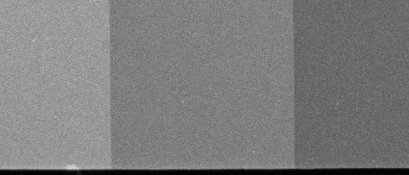kb3lms
Member
Great stuff, Mark! Keep going!
Mark;
If you repeated that experiment several times, I would guess that these differences would even out and the averages would be virtually identical.
One maxim I learned was "never do any experiment one time".
PE
Mark;
If you repeated that experiment several times, I would guess that these differences would even out and the averages would be virtually identical.
One maxim I learned was "never do any experiment one time".
PE

This graph thinks the film-speed is a hair *higher*. I stand corrected: the amount of AA has no effect on speed.


Mark, thank you for working on this developer. I have been following your discoveries with great interest, as XTol 1+1 is the only film developer I use. I was wondering if you had any data, by now, about the keeping properties of the concentrate, since quite some time has passed since you begun.
Many thanks, and good luck.

Your developer is overdoing things and should have less buffer.
 and
and

Again, the graphs show less difference than slight variations in temperature, agitation or other processing parameters will give you. If you want to lower pH without adding a new ion (citrate) to the mix, you could replace some of the sulfite with metabisulfite. Not sure it makes a big difference, but it should reduce complexity. If you reduce amount of metaborate, you also reduce buffer strength, i.e. you turn more knobs at once.The good news is the right-side rise seems to be gone. But I notice that both graphs have a bit lower EI and a bit higher contrast compared to XTOL and compared to what I was getting with earlier formulas. These differences are probably too small for folks to notice, but I'd like to know why this is happening. I'm mixing propylene glycol into the water to simulate a concentrate, and I'm wondering if PG reduces EI slightly, or if that's due to the very strong buffering, or if the citric acid could do this. So I'll try reducing metaborate and eliminating the citric acid, unless you have a better idea.
Again, the graphs show less difference than slight variations in temperature, agitation or other processing parameters will give you. If you want to lower pH without adding a new ion (citrate) to the mix, you could replace some of the sulfite with metabisulfite. Not sure it makes a big difference, but it should reduce complexity. If you reduce amount of metaborate, you also reduce buffer strength, i.e. you turn more knobs at once.

 XTOL:
XTOL:

If you run a keeping test of the dilute working solution, you will see how it performs with your tap water. By having a few volunteers run a similar test, we will learn a lot. PE
| Photrio.com contains affiliate links to products. We may receive a commission for purchases made through these links. To read our full affiliate disclosure statement please click Here. |
PHOTRIO PARTNERS EQUALLY FUNDING OUR COMMUNITY:  |


